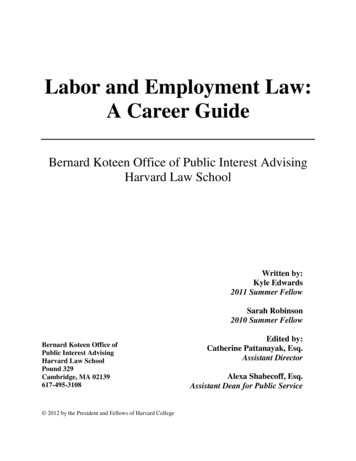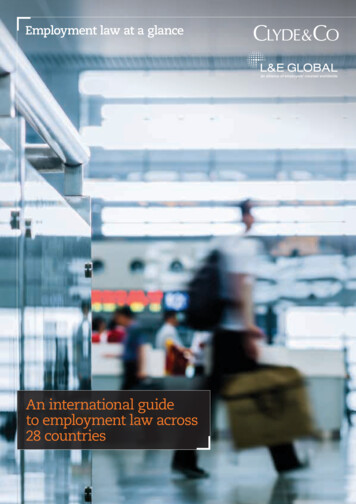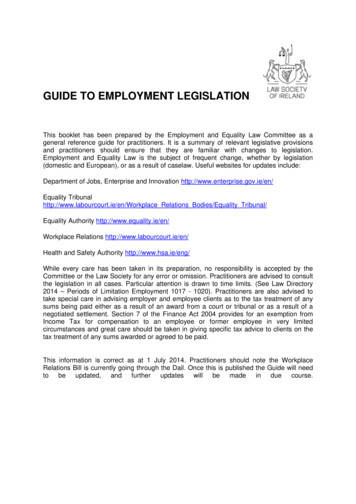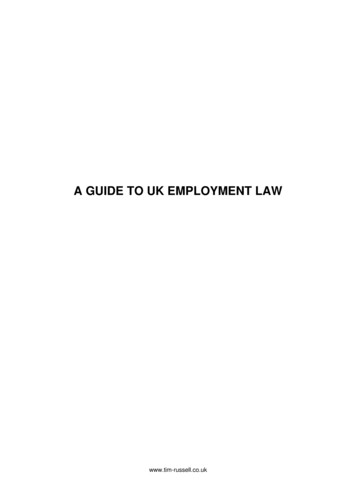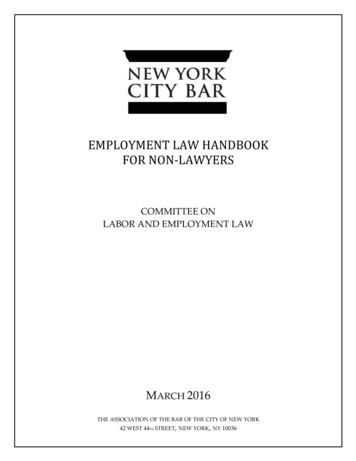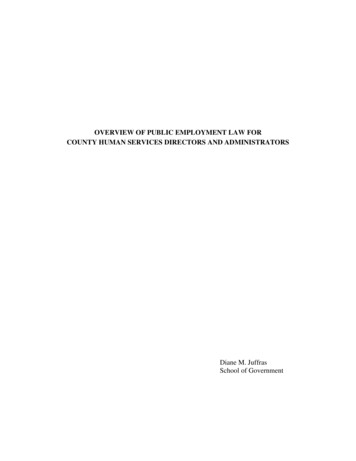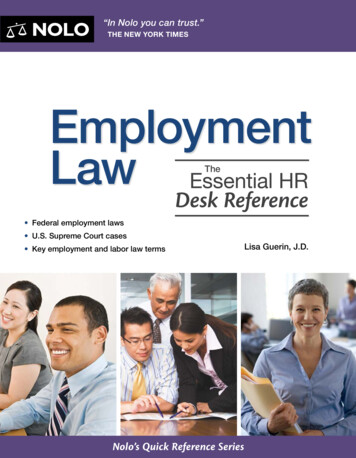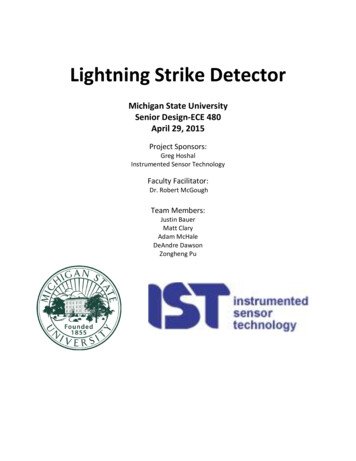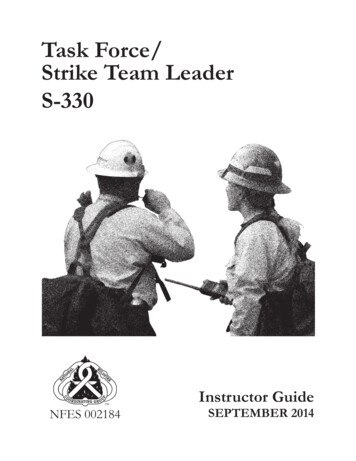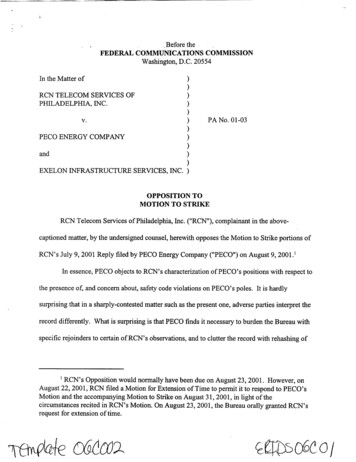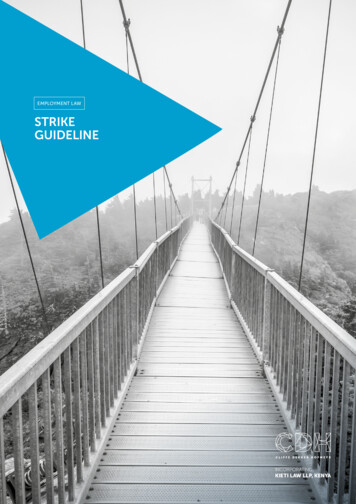
Transcription
EMPLOYMENT LAWSTRIKEGUIDELINE
All employees (actingin concert with otheremployees) have theright to strikeSTRIKE GUIDELINE cliffedekkerhofmeyr.com
STRIKE: FAQSWHAT IS A STRIKE?The Labour Relations Act, No 66 of 1995 (LRA)defines a strike as “the partial or completeconcerted refusal to work, or the retardationor obstruction of work, by persons who are orhave been employed by the same employer or bydifferent employers, for the purpose of remedyinga grievance or resolving a dispute in respect ofany matter of mutual interest between employerand employee and every reference to ‘work’ in thisdefinition includes overtime work, whether it isvoluntary or compulsory”A STRIKE CAN TAKE THE FORM OFA partial or complete refusal to workAll employees of an employer may associatethemselves with a protected strike, even if they are notmembers of the trade union initiating the dispute anddeclaring the strike.NOTE: The employer must identify and record whichemployees are on strike as this information willbecome important if the employer approaches theCourt to interdict an unprotected or violent strike.WHAT IS A PROTECTED STRIKE?A protected strike is a strike that complies with therequirements in the LRA, where the subject matter ofthe strike is legitimate and procedural requirementsare complied with prior to the strike commencing.If a strike is protected, no adverse consequences mayresult for employees who participate in protectedstrike action. Those employees are indemnifiedfrom claims for breach of contract or delict and fordamages suffered by the employer pursuant to aprotected strike. Importantly, employees are protectedfrom dismissal for participating in a protected strike.A ‘go slow’ where employees are working slowlyto put pressure on an employer to comply witha demandWHAT PROCEDURAL REQUIREMENTS MUST BECOMPLIED WITH FOR A STRIKE TO BE PROTECTED?A ‘grasshopper’ strike. This happens when theemployees go on intermittent work stoppagesabout the same demand (ie strike, return to work,strike again)The issue in dispute must be referredto the Commission for Conciliation,Mediation and Arbitration (CCMA) orBargaining Councilbut always in conjunction with the defined purpose ofattempting to resolve a mutual interest issue existingbetween the parties. The disgruntled employees willnormally express the purpose of a withholding of workin some form of a demand made to the employer.DOES A WORK STOPPAGE CONSTITUTE A STRIKE?ReferralBefore a strike notice is issued:30 Days/CertificateA. 30 days must lapse from when thedispute was received by the CCMA orBargaining Council; orA work stoppage is different to a strike.B. A certificate must be issued statingthat the dispute remains unresolvedThe difference between a work stoppage and a strikeis that there is no demand made by the participants ina work stoppage, the participants simply stop working.(The first to occur of A or B)NOTE: The distinction between a work stoppage anda strike is an important one as it has an impact on thetypes of remedies available to the employer whensuch conduct occurs.WHO MAY GO ON STRIKE?StrikenoticeA written notice stipulating thecommencement of the strike mustbe issued to the employer at least 48hours before the strike commencesAll employees (acting in concert with other employees)have the right to strike. An individual employee cannotstrike on his or her own. The LRA, however, sets outcertain limitations and requirements that must becomplied with for a strike to be protected.STRIKE GUIDELINE cliffedekkerhofmeyr.com
WHY MUST THE ISSUE IN DISPUTE BE REFERRED TOCONCILIATION BEFORE THE STRIKE?A code of good practice on collective bargaining,industrial action and picketing (the Code) was issued inDecember 2018. The Code is aimed at promoting orderlycollective bargaining, effective and speedy resolution ofdisputes, peaceful strikes and lockouts and the prevention ofprolonged violent industrial action.The Code sets out two reasons why issues in dispute mustbe referred to conciliation. Firstly to try and have the disputeresolved without resorting to industrial action and secondly,to record the demands and agree on picketing rules, lines ofcommunication and the need for minimum services.WHAT HAPPENS IF A STRIKE DOES NOT COMMENCEON THE DATE AND TIME STIPULATED IN THEWRITTEN NOTICE?relating to an unfair dismissal or where an employer pays anemployee less than the amount set out in employment lawor an employment contract.An interest dispute is a dispute to create new rights andcan form the subject of a protected strike or lockout. Anexample of such a dispute is a dispute about increase inwages or a change to working hours.WHAT ARE EXAMPLES OF INTEREST DISPUTES?The Code sets out the following examples ofinterest disputes: disputes about what the next years wages will be disputes about introducing new shift systems disputes about working hours or higher rates ofovertime payCAN EMPLOYEES STRIKE OVER AN UNLAWFUL DEMAND?The trade union should issue another notice stating the dateand time of the strike if it intends to strike. If no such noticeis issued it may lead to the inference that the trade union haswaived or abandoned its right to strike.No. An example of an unlawful demand is a demand that theemployer dismiss a manager or that employees work moreovertime than permitted in law.WHAT DISPUTES CAN EMPLOYEES STRIKE OVER?WHAT STEPS CAN AN EMPLOYER TAKE IF THE PROTECTEDSTRIKE ACTION BECOMES VIOLENT?Although the right to strike is a constitutional right,section 65 of the LRA provides limitations on the right tostrike. In terms of this section, employees are prohibitedfrom striking if they are: “Bound by a collective agreement that prohibits a strikeor lock-out in respect of the issue in dispute” “Bound by an agreement that requires the issue indispute to be referred to arbitration” Engaged in an essential or maintenance serviceIn addition, section 65 prohibits employees from strikingover an issue in dispute that can be referred to arbitration orthe Labour Court in terms of the LRA or other employmentlaw. The LRA distinguishes between disputes that can beresolved by arbitration or adjudication (rights disputes) anddisputes that can be resolved by the exercise of economicpower (interest disputes). Employees may not strike overrights disputes.NOTE: The limitations in section 65 are equally applicableto lock-outs.WHAT IS THE DIFFERENCE BETWEEN A RIGHTS DISPUTEAND INTEREST DISPUTES?The Code identifies the differences and the importance ofthe differences between right disputes and interest disputes.IN TERMS OF THE CODE:A rights dispute is a dispute that relates to existing rights andthat the LRA or other employment laws require be resolvedby adjudication or arbitration. An example is a disputeSTRIKE GUIDELINE cliffedekkerhofmeyr.comAmendments have been introduced to the LRA to deal withlengthy violent strike action. The amendments permit thedirector of the CCMA to establish an advisory arbitrationpanel. Employers can apply to the director to establish anadvisory arbitration panel. Employers can also approach theLabour Court to interdict unlawful behaviour.The employer may also institute disciplinary action againstthe employees who are acting unlawfully. In terms ofthe amendments to the LRA, the Labour Court may alsoorder the director of the CCMA to establish an advisoryarbitration panel.WHEN DOES A PROTECTED STRIKE BECOME ANUNPROTECTED STRIKE?A protected strike can only become an unprotected strike ifit continues beyond the point when the employer compliesfully and unconditionally with the demand or the strikersalter their demands. (Transport and Allied Workers Unionof South Africa obo Ngedle and others v Unitrans Fuel andChemical (Pty)Ltd [2016] 11 BLLR 1059 (CC))CAN AN EMPLOYER DISMISS EMPLOYEES FORPARTICIPATING IN A PROTECTED STRIKE?No. A dismissal in such circumstances would constitutean automatically unfair dismissal. However, misconductduring a protected strike may be the subject of appropriatedisciplinary action.
WHAT ARE THE ESSENCE OF THE AMENDMENTS TO THELRA RELATING TO THE ESTABLISHMENT OF AN ADVISORYARBITRATION PANEL?The amendments permit the director of the CCMA toestablish an advisory arbitration panel. The circumstancesof the strike or lockout will be considered by the paneland an advisory award will be established aimed athelping the parties resolve the dispute. The awardwill, among others, set out recommendations for theresolution of the dispute and the parties will have sevendays to accept or reject the award. The award is bindingon parties who accept it or persons to whom it has beenextended to by the Minister.WHEN WILL AN ADVISORY ARBITRATION PANEL BEESTABLISHED?The director must appoint an advisory arbitration panel ifordered to do so by the Labour Court or if the parties to thedispute agree to the panel being established.The director may also appoint an advisory arbitration panelon his/her own accord or on application by a party to thedispute. If a party to the dispute applies for an advisoryarbitration panel to be established or the Minister directsthat a panel be established, before establishing the panel,the director must have grounds to believe one or more ofthe listed circumstances exist:(i) ”The strike or lockout is no longer functional tocollective bargaining in that it has continued for aprotracted period of time and no resolution of thedispute appears to be imminent;(ii) there is an imminent threat that constitutionalrights may be or are being violated by personsparticipating in or supporting the strike or lockoutthrough the threat or use of violence or the threatof or damage to property; or(iii) the strike or lockout causes or has the imminentpotential to cause or exacerbate an acute nationalor local crisis affecting the conditions for thenormal social and economic functioning of thecommunity or society.”WHEN WILL THE LABOUR COURT ORDER THE DIRECTORTO ESTABLISH AN ADVISORY ARBITRATION PANEL?The Labour Court will order the director to establish a panelif there is an application to the Labour Court by a personor association materially affected by the circumstances in(ii) or (iii) above and the Labour Court considers that thecircumstances in (ii) and (iii) exist.WHO IS APPOINTED TO SIT ON THE ADVISORYARBITRATION PANEL?A senior commissioner will be appointed as the chairperson,and two assessors (one appointed by the employer and theother by the trade union).WHAT HAPPENS IF THE EMPLOYER OR THE TRADE UNIONDOES NOT APPOINT AN ASSESSOR?The director must appoint an assessor from lists providedby NEDLAC.WHAT IF THE EMPLOYER OR TRADE UNION REFUSES TOPARTICIPATE IN THE PROCEEDINGS OF THE PANEL?The director is required to appoint a person with therequisite expertise to represent the interests of that partyrefusing or failing to participate in the proceedings.DOES THE APPOINTMENT OF THE PANEL INTERRUPT ORSUSPEND THE RIGHT TO STRIKE OR LOCKOUT?No.WHAT WILL AN AWARD SET OUT?A report on factual findings, recommendations to resolvethe dispute, motivations as to why the recommendationsshould be accepted, the seven-day period within which theparties must either accept or reject the award.CAN A PARTY REJECT THE AWARD?Yes, but before doing so the trade union or employer’sorganisation must in accordance with its constitution,consult with its members. Any rejection is required tobe motivated.WHAT IF A PARTY DOES NOT ACCEPT OR REJECT THEAWARD WITHIN THE PRESCRIBED TIME PERIOD?If a party fails to accept or reject the award within sevendays, the party is deemed to have accepted the award.IS THE AWARD BINDING AND WHO DOES IT BIND?The award will be binding on the party and its members whoaccepted the award or who are deemed to have acceptedthe award. If the award is extended by the Minister in termsof s32 of the LRA it will be binding on persons who are notmembers of the parties to the council or on persons whohave rejected the award.STRIKE GUIDELINE cliffedekkerhofmeyr.com
QUESTIONS FOR CONSIDERATION:CAN A PROTECTED STRIKE LOSE THAT STATUS WHERE THEVIOLENCE IS EXTREME AND UNCONTROLLABLE?Despite attempts to interdict a protected strike on accountof violence and declare the strike unprotected, the LabourCourt is yet to make such a ruling. In previous judgements, theLabour Court has stated that it is possible to obtain this form ofrelief, but that the court should not easily adopt an approachwhich so severely limits the constitutional right to strike.The test currently suggested by the Labour Court in order tosuccesfully declare a protected strike as unprotected, is that thenature and degree of the strike violence must be such that thestrike is no longer functional to collective bargaining and that it nolonger supports the legitimate purpose of collective bargaining.While this relief has in theory been mentioned by the LabourCourt as being possible, it is yet to grant such an order and/or setout guidelines as to what degree of violence it considers sufficientfor such an order.CAN AN EMPLOYER DISMISS EMPLOYEES AS A RESULTOF OPERATIONAL REQUIREMENTS FLOWING FROM APROTECTED STRIKE?Although employees are protected from dismissal for participatingin protected strike action, the LRA does not preclude employersfrom dismissing employees based on operational requirements.However, in circumstances where the intention of a strike is toput financial pressure on an employer’s business, an employerwill have to prove that the main reason for the dismissal was theoperational requirements of the employer and did not relateto employees’ participation in the protected strike and that thereason for the dismissal and procedure followed was fair. Theemployer will also have to show that it considered alternatives toretrenchment and paid attention to letting the outcome of thestrike be determined by the normal exercise of economic power.WHAT REMEDIES ARE AVAILABLE TO AN EMPLOYER IF STRIKEACTION IS UNPROTECTED?TIPS ON EVIDENCE IN SUPPORT OF AN INTERDICTOR DISCIPLINARY ACTION RELATING TO VIOLENCE,
the Labour Court in terms of the LRA or other employment law. The LRA distinguishes between disputes that can be resolved by arbitration or adjudication (rights disputes) and disputes that can be resolved by the exercise of economic power (interest disputes). Employees may not strike over rights disputes.

